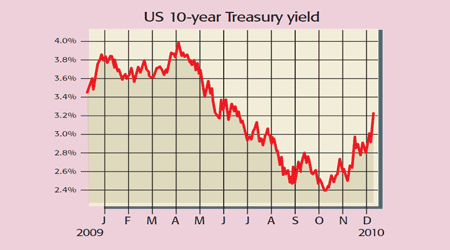
President Barack Obama’s Democrats, and their Republican opponents, reached an agreement in Congress this week that is, in effect, yet another fiscal stimulus for the US. They agreed to extend all tax cuts made under former president George W Bush (set to expire at the end of this year) for another two years. In addition, there will be a 2% cut in the employee payroll tax rate and a renewal of the extended unemployment benefits programme. Meanwhile, tax credits included in the 2009 stimulus programme will rise. Business investments will also be fully tax-deductible next year.
The deal has yet to pass through Congress. However, the boost to the economy propelled the S&P 500 index to its highest level since Lehman Brothers collapsed. Treasury yields also rose (reflecting falling prices) with the ten-year interest rate gaining 0.2% on Tuesday, thanks to the prospect of faster growth and an even bigger public debt pile.
What the commentators said
This package has “a realistic shot at passing Congress”, as James Pethokoukis pointed out on Breakingviews.com. And it should give the “flaccid economy” some pep. Analysts say it amounts to $300bn of fresh stimulus – around 2% of GDP, or 40% of the size of the first package last year. Michael Feroli of JP Morgan now sees scope for GDP to expand by 3.5% next year instead of 3%. Capital Economics thinks it would add 0.8% to its current forecast of 2%.
But while the package will inject growth in the short term, it just makes the deficit problem worse. No wonder yields rose – if the government goes for proposals that could add around $750bn to our public debt, “the fixed-income market is not exactly going to like it”, noted David Rosenberg of Gluskin Sheff.
The deficit next year is now likely to be 9.5% rather than 8.5%, according to Bricklin Dwyer of BNP Paribas. Deficits are expected for the next ten years. Overall public debt is over 80% of GDP. Costs are spiralling as the population ages. Unfortunately, Congress has hitherto proved unwilling “to address the huge gap between the people’s expectations of government services and their willingness to pay for them”, as Lex put it in the FT.
The market may now be taking on board the fact that the US “has a massive federal debt problem, which it has no intention of doing anything about”, said Marc Ostwald of Monument Securities. The US has always been seen as safe haven, while the dollar’s status as the world’s reserve currency has also underpinned confidence in its debt. But even the US can’t stretch the markets’ patience forever. “Not dealing with reality” will eventually “create a very vicious response”, said John Mauldin on Investorsinsight.com. “Ask Greece.”